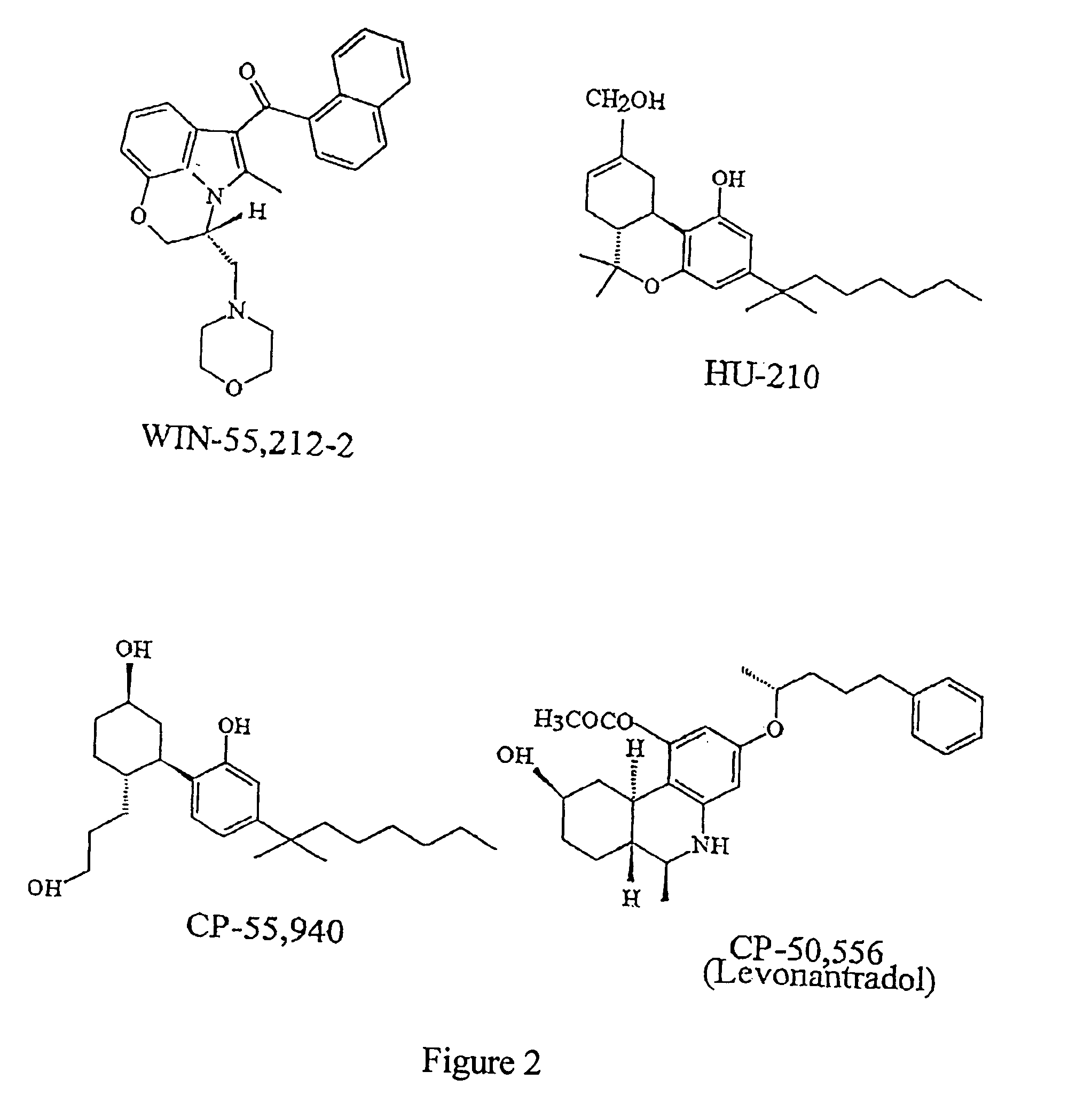Therapy with cannabinoid compounds for the treatment of brain tumors
a cannabinoid compound and brain tumor technology, applied in the direction of plant ingredients, biocide, plant growth regulators, etc., can solve the problems of ineffective or at best ineffective or merely palliative treatment of glioblastomas, and the unlikelihood of success of these therapeutic approaches can be further complicated, and achieves high treatment effectiveness, low side effects, and simple
- Summary
- Abstract
- Description
- Claims
- Application Information
AI Technical Summary
Benefits of technology
Problems solved by technology
Method used
Image
Examples
example 1
[0029] Curation of Glioblastomas in Rats
[0030] Male Wistar rats (250-300 g in body mass) were anaesthetized with 3% isofluorane in an oxygen mixture (0.8 l / min) and protoxide (0.4 l / min). 5.times.10.sup.8 C6 glioblastoma cells were prepared in 100 .mu.l of saline solution buffered with phosphate (PBS) and supplemented with 0.1% glucose, and stereotaxically injected in the frontal parietal lobule of the right hemisphere (4 mm to the right of bregma, 4.5 mm depth from the cranium) (Izquierdo, M et al., Gene Ther. 2, 66-69, 1995). The rats received dexamethasone (2 mg / l) and tetracycline (75 mg / kg of body weight) in water for 3 days before and 7 days after inoculation of the cells. A thorough monitoring of the tumors was performed by magnetic resonance with the methods described by other authors (Izquierdo, M et al., op cit; Corts, M. L., de Felipe, P., Martin, V. Hughes, M. A. & Izquierdo, M. Gene Ther. 5, 1499-1507, 1998).
[0031] The administration of cannabinoids to rats began 12 day...
example 2
[0033] Curation of Glioblastomas in Immunodeficient Rats.
[0034] Tumors were induced in RAG-2.sup.- / - rats by subcutaneous inoculation of 5.times.10.sup.6 C6 glioblastoma cells in 100 .mu.l of PBS supplemented with 0.1% glucose. About 10 days later, when the average volume of the tumors was 250 mm.sup.3 (interval 200-300 mm.sup.3) the animals were divided randomly into 3 groups and they were injected during 7 days with vehicle, 500 .mu.g of THC or 50 .mu.g of WIN-55,212-2 per day in 100 .mu.l of PBS supplemented with 5 mg / ml of delipidized and dialyzed BSA. The tumor sizes were measured by a caliper and their volume calculated according to (4.pi. / 3).times.(width / 2).sup.2.times.(length / 2). As shown in FIG. 4a, the size of tumors was much smaller in animals treated with THC or WIN-55,212-2 than in control animals. In FIG. 4b are shown examples of tumor bearing mice and tumors dissected after treatment with or without cannabinoids for 7 days.
example 3
[0035] Implication of Cannabinoid Receptors in the Death of Glioblastoma Cells.
[0036] C6 glioblastoma cells were cultivated at 37.degree. C. and 5% CO.sub.2 in F-12 medium supplemented with calf fetal serum at 10%. 24 h before the start of the experiment the cells were transferred to an F-12 medium free of serum and supplemented with insulin (5 .mu.g / ml), transferrine (10 .mu.g / ml), sodium selenite (5 .mu.g / ml) and delipidized and dialyzed BSA (10 mg / ml). The medium was renovated every 48 h and the cell viability was determined by the MTT method (Sanchez, C., Galve-Roperh, I., Canova, C., Brachet, P. & Guzman, M., op cit.). As shown in FIG. 5a, THC was capable of inducing the death of C6 glioblastoma cells. Additionally, when SR141716 (a selective antagonist of CB.sub.1) and SR144528 (a selective antagonist of CB.sub.2) were simultaneously added to the medium the death cell induced by THC was prevented.
[0037] In order to confirm that both receptors were present in the C6 cells the c...
PUM
| Property | Measurement | Unit |
|---|---|---|
| Concentration | aaaaa | aaaaa |
| Selectivity | aaaaa | aaaaa |
Abstract
Description
Claims
Application Information
 Login to View More
Login to View More - R&D
- Intellectual Property
- Life Sciences
- Materials
- Tech Scout
- Unparalleled Data Quality
- Higher Quality Content
- 60% Fewer Hallucinations
Browse by: Latest US Patents, China's latest patents, Technical Efficacy Thesaurus, Application Domain, Technology Topic, Popular Technical Reports.
© 2025 PatSnap. All rights reserved.Legal|Privacy policy|Modern Slavery Act Transparency Statement|Sitemap|About US| Contact US: help@patsnap.com



